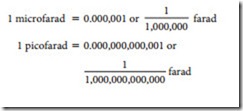This chapter focuses on capacitance and its application to DC circuits. The effects of capacitance in a circuit are discussed in Chapter 25.
Principles of capacitance
capacitance is the ability of a device to store electrical energy in an electrostatic field. The symbol for capacitance is c. A capacitor is a device that possesses a specific amount of capacitance. A capacitor is made of two conductors separated by an insulator (Figure 20-1). The conductors are called plates and the insulator is called a dielectric. Figure 20-2 shows the symbols for capacitors.
When a DC voltage source is connected to a capacitor, a current flows until the capacitor is charged. The capacitor is charged with an excess of electrons on one plate (negative charge) and a deficiency of electrons
on the other plate (positive charge). The dielectric prevents electrons from moving between the plates. Once the capacitor is charged, all current stops. The capacitor’s voltage is equal to the voltage of the voltage source.
A charged capacitor can be removed from the volt- age source and used as an energy source. However, as energy is removed from the capacitor, the voltage diminishes rapidly. In a DC circuit, a capacitor acts as an open circuit after its initial charge. An open circuit is a circuit with an infinite resistance.
c a u t i o n !
Because a capacitor can be removed from a volt- age source and holds the potential of the voltage source indefinitely, treat all capacitors as though they were charged. Never touch both leads of a capacitor with your hand until you have dis- charged it by shorting both leads together or using a shorting stick. A capacitor in a circuit can hold a potential indefinitely if it does not have a dis- charge path.
The amount of energy stored in a capacitor is in proportion to the size of the capacitor. The capacitors used in classrooms are usually small and deliver only a small shock if discharged through the body. If a capacitor is large and charged with a high voltage, however, the shock can be fatal. Charged capacitors should be treated like any other voltage source. Use a commercial shorting stick or a screwdriver with an insulated handle and a lead attached to discharge capacitors.
The basic unit of capacitance is the farad (f). A farad is the amount of capacitance that can store 1 coulomb (C) of charge when the capacitor is charged to 1 volt. The farad is too large a unit for ordinary use, so the microfarad (mf) and picofarad (pf) are used. The letter C stands for capacitance.
Questions
1. What is capacitance?
2. Draw the symbol for a fixed and a variable capacitor.
3. What precautions should be observed when handling capacitors?
4. What is the basic unit for measuring capacitance?
What units are normally associated with capacitors?

